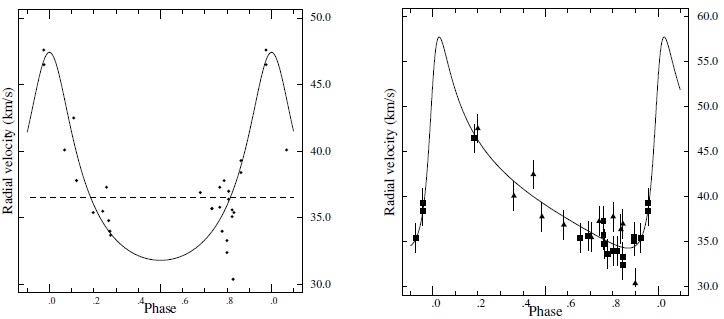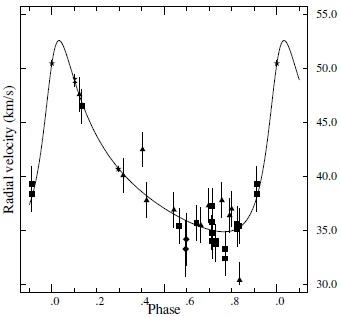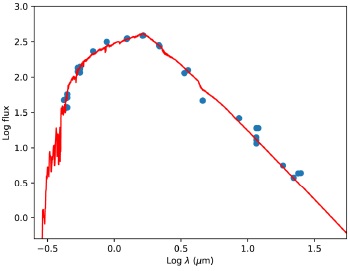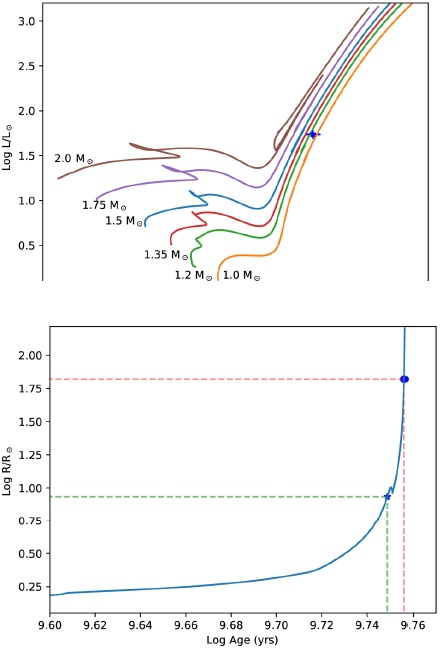1. INTRODUCTION
δ Mus (HIP 63613, HD 112985, HR 4923, ICRS J2000 13:02:16.26474-71:32:55.8752) is a neglected bright K2 III binary star with V = 3.62 mag and no sign of variability above 4 mmag (ESA 1997). It was part of the sample of spectroscopic binaries containing late-type giants that was statistically analysed by Boffin et al. (1993). Its spectroscopic orbit, however, has been obtained by Christie (1936) with no revision since its publication, despite the fact that it was classified “poor” in all versions of the DAO Spectroscopic Binary Catalogues. In anticipation of the Gaia mission (Gaia Collaboration et al. 2016), de Bruijne & Eilers (2012) called for an improved estimate of the radial velocity to be used in the Hipparcos-Gaia Hundred-Thousand-ProperMotion project, without any success. Even though δ Mus is observed by Gaia (it was missing from Gaia Data Release 1, now present in Gaia Data Release 2 [Gaia Collaboration et al. 2018]), its radial velocity might still have to come from a ground-based facility (Gaia DR2 does not report any velocity for that object).
The binary nature of δ Mus was also noticed by Hipparcos and will likely be noticed by Gaia as well (the single star model was imposed to all the objects present in Gaia DR2, whether ultimately appropriate or not). The orbital period is short enough to be well covered by Gaia, making this object very well suited for the early validation of the Gaia non-single star processing pipeline, especially as an example of a bright star. It is therefore mandatory to first validate the ground-based solution which has been considered preliminary for the past 80 years.
The history and status of the only spectroscopic orbit of this system together with an alternative fit are described in § 2, followed by the astrometric counterpart (§ 3). The benefit from adding just five radial velocities is the topic of § 4, while § 5 presents the physical properties we can derive for this system.
2. SPECTROSCOPIC ORBIT
The first measurement of the radial velocity of δ Mus dates back to 1904 and it was quickly recognised as variable (Lunt 1919). However, despite that early identification, none of the sets of velocities recorded at the Cape Observatory (Spencer Jones 1928) and at the Lick Observatory (Campbell 1928) was accompanied by any tentative orbit. Finally, Christie (1936) combined the two sets and published the first (and so far unique) spectroscopic orbit (847-day period) of that system. Despite the orbit being described as preliminary by the author himself, it has not been confirmed by any independent study for the past 80 years. Actually, only a handful of new radial velocities have been reported since 1928 (Stacy et al. 1980; De Medeiros et al. 2014).
With the exact same radial velocities as Christie (1936), it is nevertheless possible to derive a rather different solution, in particular for the period which is essentially one half of the original estimate. That very ill-defined solution is listed in Table 1 together with Christie’s orbit. The two solutions are plotted in Figure 1. The reason why our alternative orbit is so poorly constrained is clear from the plot: with the new period, there are no data covering the upper part of the curve.
Table 1 Two alternative spectroscopic orbits.*
| Parameter | Christine (1936) | Alternative solution |
|---|---|---|
| P (days) | 874 | 424.0±1.2 |
| T0 (JD-2 400 000) | 21790 | 16597±22 |
| e | 0.4 | 0.60±0.50 |
| ω(°) | 0 | 126±51 |
| K1 (km s-1) | 7.8 | 12.0±9.7 |
| V0 (km s-1) | +36.5 | +41.0±3.4 |
*Based on the original spectroscopic data (Spencer Jones, 1928; Campbell, 1928).

Fig. 1 Original solution by Christie (1936) retrieved from
Table 2 Astrometric orbit from hipparcos (ESA, 1997).
| Parameter | Value |
|---|---|
| P (days) | 422.0266±5.3908 |
| T0 (JD-2 400 000) | 47947.6687±27.5934 |
| e | 0.4918±0.1241 |
| ω (°) | 316.39±26.13 |
| Ω (°) | 59.27±5.29 |
| i (°) | 120.07±6.02 |
| a0 (mas) | 11.67±1.02 |
The original papers did not report the uncertainties on the observations. The residuals derived from our solution have a zero mean and a standard deviation of 1.6 km s−1. Assuming that value as uncertainty for all the velocities, the goodness of fit, F2, can be used to assess the quality of the fits. It is defined as
where ν is the number of degrees of freedom and χ2 is the weighted sum of the squares of the differences between the predicted and the observed positions (Kovalevsky & Seidelmann 2004). F2 (Wilson & Hilferty’s cube root transformation, Wilson & Hilferty 1931) follows a N(0, 1) distribution (Stuart & Ord 1994). For Christie’s orbit and ours, the F2 are respectively 3.66 and 0.78. In terms of fit only, our alternative solution fits the data much better than the original one.
3. ASTROMETRIC OBSERVATIONS
Like every other objects in that magnitude range, δ Mus was observed by Hipparcos (ESA 1997). However, in this particular case, the binary nature of the source was also noticed and the full-fledged orbital model was even necessary to fit the observations. Despite the availability of a spectroscopic orbit (Christie 1936), the seven parameters of the astrometric orbit were fitted independently.
Even though the astrometric period and our revised spectroscopic one look similar, the consistency of the eccentricities comes from their rather large uncertainties only and the arguments of the periastron (ω) are totally discrepant. Pourbaix & Boffin (2003) showed that no satisfactory astrometric fit could be based on Christie’s orbit, so if one looks for an improved consistency between spectroscopy and astrometry, it should come from the radial velocities.
4. JUST FIVE MORE POINTS
Whereas four measurements of the radial velocities have been reported since 1928, only two are public (Stacy et al. 1980). Obtained at Cerro Tololo, they date back to 1979 but were taken just one day apart and would thus likely count as one epoch in any orbital fit. The remaining two radial velocities were measured with Coravel South in the framework of obtaining the radial velocity of the Hipparcos stars. The average of the two observations was published by De Medeiros et al. (2014) but the individual measurements were kindly supplied (S. Udry, private communication) for a previous investigation (Pourbaix & Boffin 2003). A fifth radial velocity was derived from a public FEROS spectrum, retrieved from the ESO Science Archive [Prog. Id. 072.D-0235(B)]. The FEROS spectrum, obtained on 6 March 2004, had an exposure time of 25 s and a signal-to-noise ratio of about 70, at a spectral resolution of 48,000. The radial velocity was derived by cross-correlating the spectrum with a synthetic spectrum of a 4500 K, log g=2.5 star.
With these five points added to the set originally used by Christie (1936), the baseline grows from 18 to exactly 100 years. Owing to the poor precision of the original radial velocities (about 1.6 km s−1) and even the Cerro Tololo ones (≈ 2.6 km s−1) with respect to the Coravel ones (≈ 0.26 km s−1) and the latest FEROS one (≈ 0.56 km s−1), the likely discrepancy between the velocity zero points of the five observatories is neglected. For completeness, the radial velocity measurements of δ Mus are provided in Table 3. The adopted weight is the reciprocal of the square of the uncertainty. The resulting orbit is listed in Table 4 and plotted in Figure 2. That orbit is characterised by an F2 of 0.87, slightly larger than with our previous solution but still within the boundaries of a good fit.
Table 3 Radial velocity measurements of δ mus. the phases and residuals are derived from the orbit in Table 4.
| Epoch JD-2, 400,000.0 | Phase | Rad. Vel (km/s) | Uncertainty (km/s) | Residual (km/s) | Ref. |
|---|---|---|---|---|---|
| 16519.79 | 0.726 | 34.00 | 1.6 | -0.96 | 2 |
| 16564.79 | 0.833 | 35.40 | 1.6 | +0.10 | 2 |
| 16874.82 | 0.565 | 35.40 | 1.6 | -0.84 | 2 |
| 16938.62 | 0.716 | 34.00 | 1.6 | -1.02 | 2 |
| 18380.49 | 0.124 | 47.60 | 1.6 | +0.12 | 1 |
| 19078.79 | 0.774 | 32.40 | 1.6 | -1.59 | 2 |
| 19078.79 | 0.774 | 33.30 | 1.6 | -2.49 | 2 |
| 19098.83 | 0.821 | 35.10 | 1.6 | +0.43 | 2 |
| 19098.83 | 0.821 | 35.60 | 1.6 | -0.07 | 2 |
| 19949.35 | 0.831 | 30.40 | 1.6 | -4.91 | 1 |
| 20199.62 | 0.422 | 37.80 | 1.6 | -0.42 | 1 |
| 21769.54 | 0.132 | 46.50 | 1.6 | -0.39 | 2 |
| 22015.72 | 0.714 | 34.80 | 1.6 | -0.23 | 2 |
| 22022.72 | 0.731 | 33.70 | 1.6 | -1.26 | 2 |
| 22409.84 | 0.646 | 35.70 | 1.6 | +0.21 | 2 |
| 22409.84 | 0.646 | 35.70 | 1.6 | +0.21 | 2 |
| 22439.74 | 0.716 | 35.80 | 1.6 | +2.27 | 2 |
| 22439.74 | 0.716 | 37.30 | 1.6 | +0.77 | 2 |
| 22456.44 | 0.756 | 37.80 | 1.6 | +2.90 | 1 |
| 22472.40 | 0.793 | 36.40 | 1.6 | +1.46 | 1 |
| 22473.38 | 0.796 | 37.00 | 1.6 | +2.02 | 1 |
| 22520.54 | 0.907 | 38.4 | 1.6 | +1.20 | 2 |
| 22520.54 | 0.907 | 39.30 | 1.6 | +0.30 | 2 |
| 22694.65 | 0.319 | 40.10 | 1.6 | -0.16 | 1 |
| 22729.58 | 0.401 | 42.50 | 1.6 | +3.97 | 1 |
| 22840.33 | 0.663 | 35.50 | 1.6 | +0.16 | 1 |
| 22854.39 | 0.696 | 37.30 | 1.6 | +2.19 | 1 |
| 23212.39 | 0.542 | 36.90 | 1.6 | +0.38 | 1 |
| 43969.71 | 0.595 | 33.30 | 2.6 | -2.64 | 3 |
| 43970.70 | 0.598 | 34.20 | 2.4 | -1.71 | 3 |
| 48372.721 | 0.000 | 50.48 | 0.27 | -0.01 | 4 |
| 49766.882 | 0.295 | 40.70 | 0.26 | -0.08 | 4 |
| 53070.59492 | 0.102 | 48.90 | 0.56 | +0.11 | This work |
1: Spencer Jones (1928); 2: Campbell (1928); 3 Stacy et al. (1980); 4: Coravel (Udry S. Priv. Comm., 2001).
Table 4 Spectroscopic orbit based on all the available data.
| Parameter | Value |
|---|---|
| P (days) | 423.2±0.10 |
| T0 (JD-2 400 000) | 25945±5.5 |
| e | 0.52±0.06 |
| ω (°) | 319±4.2 |
| K1 (km s-1) | 8.8±0.38 |
| V0 (km s-1) | +40.2±0.20 |

Fig. 2 New, improved orbit for δ Mus, based on the elements in Table 4. The squares denote the Lick data (Campbell 1928), the triangles are the Cape ones (Spencer Jones 1928), the diamonds are the Cerro Tololo velocities (Stacy et al. 1980), the stars are the Coravel South data (S. Udry, priv. comm.), and the diabolo denotes the FEROS based velocity (this work).
The agreement between the spectroscopic and astrometric solutions is now much better and yet the two fits are still independent. Even though there are twice as many astrometric observations as spectroscopic ones, the former cover 2.6 orbital periods only, thus making the spectroscopic solution much more precise (and hopefully accurate). Assuming it in the astrometric one would reduce the number of fitted parameters and therefore increase their precision. There are essentially two ways of using a spectroscopic orbit in an astrometric orbital fit and comparing the results of the two approaches makes it possible to assess reliability of both astrometric fits (Pourbaix 2001; Pourbaix & Arenou 2001).
Plugging the elements from Table 4 into such a fit now leads to very consistent results: all the statistical indicators prescribed by Pourbaix & Arenou (2001) are satisfied. Constraining the astrometric fit with ω, e, P, T0, and even K1 gives an astrometric solution whose error bars are substantially reduced as fewer elements are fitted (Table 5).
Table 5 Revised astrometric orbit based on the hipparcos (ESA, 1997).*
| Parameter | Value |
|---|---|
| Ω (°) | 58±2.7 |
| i (°) | 120±2.3 |
| a0 (mas) | 12.1±.35 |
| ϖ (mas) | 35.6±0.56 |
| μα∗ (mas yr-1) | 263.6±0.48 |
| μδ (mas yr-1) | -23.4±0.48 |
*Data and the spectroscopic solution fromTable 4. a0 denotes the semi-major axis of the absolute orbit of the photocentre of the system.
5. PHYSICAL PROPERTIES
2MASS (Cutri et al. 2003) reports a magnitude K = 0.946 ± 0.282 which, for a red giant, translates to Teff = 4500K and a bolometric correction in K of 2.3 (Bessell et al. 1998). We have confirmed this value, by downloading the photometry of δ Mus over the widest spectral range from CDS/Simbad, using Vizier and compared it to a solar-metallicity model of a Teff =4500 K, log g = 2.5 star (Castelli & Kurucz 2004, 2). A simple rescaling provides a perfect match between observations and model (Figure 3). This also indicates that the companion does not produce any noticeable flux in the wavelength range from 420 nm to 60μm.

Fig. 3 Comparison between the photometry of δ Mus as retrieved from Vizier and a model for a Teff =4500 K, log g = 2.5 from Castelli & Kurucz (2004). The color figure can be viewed online.
Such a temperature is associated to a star with a mass close to 1.5 M⊙ (Martig et al. 2016). This can be refined by placing the star in an HertzsprungRussell diagram. Using our revised Hipparcos parallax (̟ϖ = 35.6±0.56 mas), we can derive a bolometric luminosity of Mbol = 1.00, or L/L⊙ = 31.24. With the given temperature, we obtain a radius of the giant of 8.6R⊙. Assuming a solar metallicity (Eggen 1993), the evolutionary tracks of Bertelli et al. (1994) bracket the mass in the range 1.05 − 1.35 M⊙ (Figure 4).

Fig. 4 (Top) Hertzsprung-Russell diagram with the position of δ Mus indicated with a star, compared to evolutionary tracks from Bertelli et al. (1994). (Bottom) Evolution of the radius of a 1.2 M⊙ stellar model from Bertelli et al. (1994). The current position of δ Mus is indicated with a star, while the value of 66 R⊙ that would lead to Roche-lobe overflow (see text) is shown as a dot. The color figure can be viewed online.
The orbit from Table 4 results in a spectroscopic mass function, f(m), of 0.0190 ± 0.0034 M⊙. Combined with the mass of the primary and the inclination from the astrometry (Table 5), this yields a ≈ 0.4 M⊙ secondary. With such a mass, it is either a ≈M3 dwarf (Torres et al. 2010) or a helium white dwarf (Kepler et al. 2007), in which case it would have to be the result of some binary interaction that cuts the normal stellar evolution. This would be quite surprising as the eccentricity of the system is quite large, and not in agreement with the circular orbit we would expect for such a post-mass transfer system - in fact the eccentricity is well-above the envelope found for post-mass transfer red giants (Van der Swaelmen et al. 2017). Munari & Zwitter (2002) list δ Mus as a reference star for their atlas of symbiotic stars, and indeed its spectrum exhibits no emission line, nor any sign of accretion - a white dwarf companion is therefore not detected. Moreover, the star is not known for any variability that could betray some accretion onto a compact object. We conclude therefore that a main-sequence M star is much more likely.
From the mass of both components, the period and the parallax, the semi-major axis of the relative orbit turns out to be about 46 mas, which can be resolved with interferometric facilities. If the secondary is an M dwarf, the difference is of the order of 9 magnitudes in V and even less in K - one cannot therefore exclude the possibility of resolving the two components with the GRAVITY instrument (General Relativity Analysis via VLT Interferometry) attached to the Very Large Telescope Interferometer (VLTI; Gravity Collaboration et al. 2017), and we encourage the community to do so. Given the brightness of δ Mus, this wouldn’t require much observing time. We note that the angular diameter of δ Mus would be ≈ 3 milli-arcseconds and would thus relatively easily be resolved by the VLTI.
The semi-major axis of the relative orbit (a) and the semi-major axis of the absolute orbit of the photocenter (a0, Table 5) are linked through the fractional mass and the fractional luminosity of the components:
This yields a fractional luminosity consistent with 0. That does not come as a surprise as the dynamic range of Hipparcos does not exceed 4 mag (whereas we expect the magnitude difference to be of the order of 9 mag). One can therefore assume that the photocenter is the primary and, indeed, the astrometry based amplitude of the radial velocity curve (K1,astr = 9.8 ± 0.8 km s−1) matches the spectroscopic estimate (Table 4).
The semi-major axis of the relative orbit is 1.29 au and, with the current parameters, the Roche lobe radius of the primary at periastron is about 66 R⊙, a value much larger than the current radius; the primary is therefore well inside its Roche lobe. According to the stellar evolutionary tracks, however, in about 95 Myr, the giant star will have reached such a radius and Roche lobe overflow will occur. As the mass ratio is well above unity (about 3.4 for now), this mass transfer will be dynamically unstable, leading to the formation of a common envelope and the spiral-in of the companion. The end product will be a short period (less than a few days) binary containing a ≈ 0.38 M⊙ He WD (the helium core mass at the start of the mass transfer) and an M dwarf. Thus δ Mus is a nice example of a progenitor of He WD binaries.
6. CONCLUSION
Using the latest available spectroscopic data, we have established that the orbital period of the system containing δ Mus is 423 days, confirming the Hipparcos result and showing that the community has been lured by an alias for the past 80 years.
Alhough δ Mus has already been observed by Gaia, a first tentative astrometric orbit will come out with the third data release anticipated for late 2020. Observations with GRAVITY could be used to further constraint the astrometric orbit, and in the case Gaia can observe it, provide a useful test bench for the handling of very bright stars with Gaia.
The orbit of δ Mus from Christie (1936) was graded 1 (i.e “worst”) in











 nova página do texto(beta)
nova página do texto(beta)


